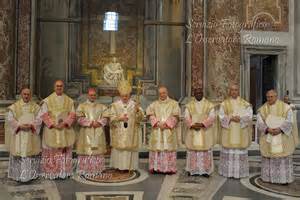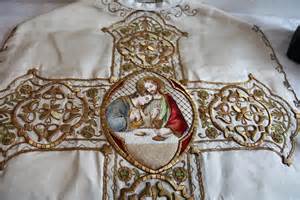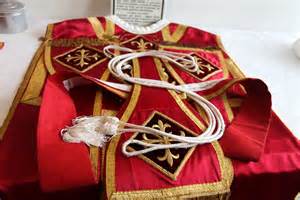
Did you ever happen to wonder…why so many colors in the Roman Liturgy?
What do they all mean?
 The use of color plays an important role in the Roman Liturgy because color often signifies a particular theme or even a certain emotion. In ancient times, even during the medieval era, churches didn’t always have all of the liturgical colors, so they would simply use what they had on hand. It was not uncommon to see what was considered as the parish’s best vestment set, be it red or green, being worn on a greater feast day, such as Christmas, even if this color was not associated with the feast.
The use of color plays an important role in the Roman Liturgy because color often signifies a particular theme or even a certain emotion. In ancient times, even during the medieval era, churches didn’t always have all of the liturgical colors, so they would simply use what they had on hand. It was not uncommon to see what was considered as the parish’s best vestment set, be it red or green, being worn on a greater feast day, such as Christmas, even if this color was not associated with the feast.
St. Pius V’s codification of the Roman Missal in 1570 changed this though and strictly established the liturgical colors and the particular instances for which they should be used. Today, the Roman Mass has five standard liturgical colors: Green, White, Red, Violet, and Black. Each of these colors is assigned to a particular type of saint or feast day.
Taking a short glance at the colors and their meanings, lets start with the color green.  Green is the color of life. Of growing things. In the context of the sacred liturgy, green signifies supernatural life and thereby the growth of grace in a soul which should continue after the major redemptive acts of Our Lord’s Nativity and His Passion and Resurrection.
Green is the color of life. Of growing things. In the context of the sacred liturgy, green signifies supernatural life and thereby the growth of grace in a soul which should continue after the major redemptive acts of Our Lord’s Nativity and His Passion and Resurrection.
White. White is used for most feasts of the Persons of the Holy Trinity, particularly of Our Lord Jesus Christ and for feasts of Our Lady. White is also used for the classes of non-martyr saints; Confessors, Doctors, Virgins, and Widows.
 Next is Red. The color red is often associated with blood, this shade is dedicated to the martyrs, who victoriously shed their very life for Christ. Similarly, red is applied to certain feasts of Our Lord to indicate His redemptive triumph over His Passion, such as the Feast of the Precious Blood.
Next is Red. The color red is often associated with blood, this shade is dedicated to the martyrs, who victoriously shed their very life for Christ. Similarly, red is applied to certain feasts of Our Lord to indicate His redemptive triumph over His Passion, such as the Feast of the Precious Blood.
Violet. Violet is a melancholy color associated with sorrow or contrition and thus signifies penance. This color is used for Masses or ceremonies with a penitential spirit, such as the Sundays and ferials during Advent and Lent, as well as for Ember and Rogation days. Violet is also used for those votive Masses that beseech God’s favor, such as the Mass for the Unity of the Church, for the Propagation of the Faith, for the Sick, or for a Good Death.
It should also be mentioned that the liturgical shade of violet or viola differs from that of purple, not only in color and use, but more importantly in significance. Both colors are made from a mixture of red and blue but violet has more blue while purple has more red.
To learn more about Liturgical colors, their deeper meaning, and other liturgical colors used in the Roman Rite out of custom, listen to Learning about the Roman Liturgy with Louis Tofari on Magnificat Radio at www.magnificatmedia.com at 10am, 1pm, 6:30pm, and 10pm, CDT USA ~ “Living Our Faith”© . To purchase books and materials mentioned on Learning about the Roman Liturgy with Louis Tofari visit this link: Romanitas Press
Here is some beautiful music
